

"There was a good entry of 174 problems from 84 composers. Some of the entries were unthematic and some unsounds (composers are being notified separately) but the vast majority of the remainder were interesting works in a wide variety of styles. It would have been possible to award twice as many commendations but it seemed fairer to give certain not strongly thematic problems a chance to do better in another tourney. My Thanks to all the composers and specially to those who sent accompanying messages.
I acted both as judge and as tourney controller; my co-judge, Friedrich Chlubna, preferred to study the problems without knowing the composers’ names. Nevertheless we found that we were in agreement more often than we expected!. Thank you, Friedrich, for your important contribution to this jubilee.
Finally a brief personal comment on the model mates which some composers seem to find valuable. Although I enjoy model mates I think them out of place in the modern H#2. They are so obvious and unparadoxical, whereas (if the problem is well constructed) clumsy mates tend to go with subtle and even elegant strategy. I have not, however, downgraded any problems in this tourney simply because they contain model mates. (CJF)"
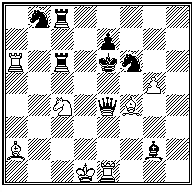 |
 bd7 bd7  :e4+ 3. :e4+ 3. :e4 :e4  e3# e3#
1. We thing that this problem shows the most interesting reason for the tematic moves; avoidance of unpin on White’s second move. The dangers of symmetry have been skilfull avoided. |
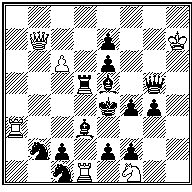 |
 f3+ f3+  d:d3+ 2. d:d3+ 2. :d3 :d3  c7# c7#
1. |
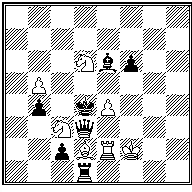 |
 :c3 :c3  :c3+ 2. :c3+ 2. d3 d3  e3# e3#
1. 1. |
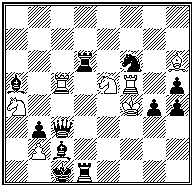 |
 :e5+ :e5+  :e5+ 2. :e5+ 2. d1-d2 d1-d2  f1# f1#
B) 1. In addition to the thematic requirement there is a combination of well known motifs arranged with strategic intensity: mutual interferences between the two black Rooks, black halfpin and double pin mates. The best entry in which the thematic checks are given by a battery. |
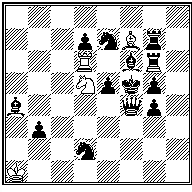 |
 e4 e4  :f6+ 2. :f6+ 2. :f6 :f6  :e7# :e7#
1. 1. Cyclic Zilahi and cyclic white moves. The thematically required checks seem rather incidental in this context; that and the perfunctory nature of the first black moves just prevent this fine problem from winning a prize. |
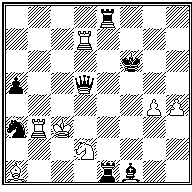  h4ð
f5 h4ð
f5 |
 :d2+ :d2+  :d2+ 2. :d2+ 2. e8-e5 e8-e5  b6# b6#
B) 1. |
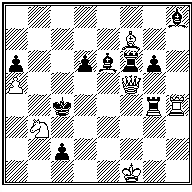 |
 e4 e4  :e6+ 2. :e6+ 2. d3 d3  h3# h3#
1. |
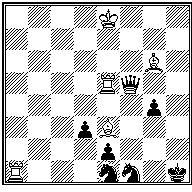 |
 e4 2. e4 2. :e4+ 2. :e4+ 2. g2 g2  h5# h5#
1. |
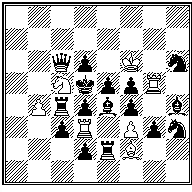 |
 :f2 :f2  :d4+ 2. :d4+ 2. e:d4 e:d4  f:e4# f:e4#
1. This very heavy position has an offputting appearance but the logic of the play is impressive and the interchange of white moves between the solutions is most appropriate in this theme. With both White and Black working hard to get black pieces out of the way a crowed position is inevitable and the fact that it is at all to prevent cooks by the white Knight is a wonder in itself. |
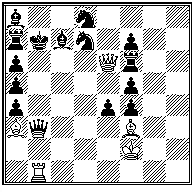 |
 :b1 :b1  :e4+ 2. :e4+ 2. b6 b6  :b1# :b1#
1. |
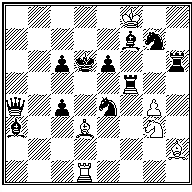 |
 c5 c5  :e4+ 2. :e4+ 2. d5 d5  c2# c2#
1. |
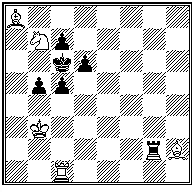  b3ð f6 b3ð f6 |
 c2 c2  :c5+ 2. :c5+ 2. :c5 :c5  g1# g1#
B) 1. Black anticipatory selfpins in fine economy. |
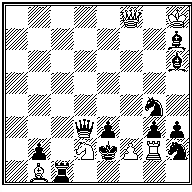  d2ð d6 d2ð d6 |
 c2 c2  f:e3+ 2. f:e3+ 2. d3 d3  a3# a3#
B) 1. |
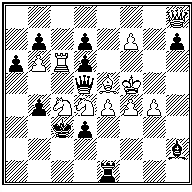  h8ðc8 - 2.sol. h8ðc8 - 2.sol. |
 :c4 :c4  :c4+
2. :c4+
2. :c4 :c4  c8# c8#
1.  :e5+ :e5+  :e5+
2. :e5+
2. :d4 :d4  c4# c4#
B) 1.  :d4 :d4  :d4+
2. :d4+
2. :d4 :d4  h8# h8#
1.  :c6 :c6  :c6+
2. :c6+
2. :c4 :c4  d4# d4# |
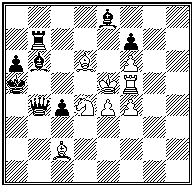 |
 :d6+ :d6+  :d6+ 2. :d6+ 2. b5 b5  c6# c6#
1. A pleasant Zilahi with a nice touch in the crossing of the mating square or line at Black’s second move. |
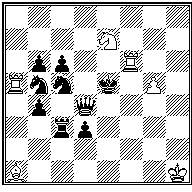  g5ð f5 g5ð f5 |
 e4 e4  :b5+ 2. :b5+ 2. d5 d5  :c6# :c6#
B) 1. Familiar but attractive double pin mates fitted to our theme with rather simple square-blocking motivations. |
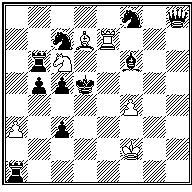  a3ð
e3; C) a3ð
e3; C)  a3ð e2 a3ð e2 |
 :d7 :d7  :d7+ 2. :d7+ 2. c4 c4  a5# a5#
B) 1. C) 1. This stands very much in the shadow of the 3rd Price winner. Its constructions is less successful and indeed the bRa1 appears to be unnecessary. Nevertheless it deserves a mention if only for its attractive mates with the black King on three squares in a line. |
The award becomes final on March 24th 1999 (claim to CJF at 10 Tinwell Road, GB-Stamford PE9 2QQ), after which the prizes will be distributed. A note of any alteration will be published in "The Problemist" during 1999,
CJF & FC, September 1998.